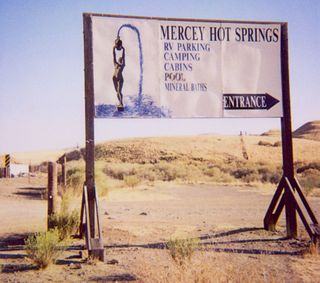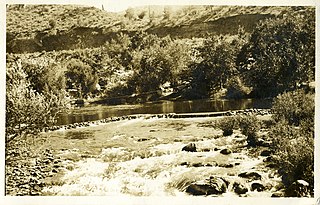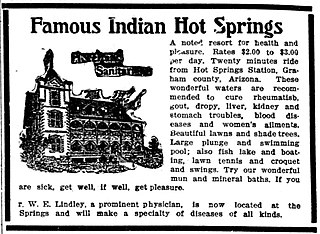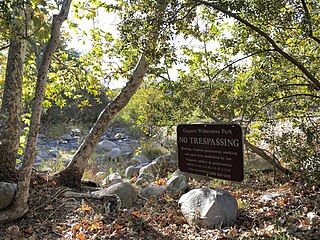
The San Bernardino Valley is a valley in Southern California located at the south base of the Transverse Ranges. It is bordered on the north by the eastern San Gabriel Mountains and the San Bernardino Mountains; on the east by the San Jacinto Mountains; on the south by the Temescal Mountains and Santa Ana Mountains; and on the west by the Pomona Valley. Elevation varies from 590 feet (180 m) on valley floors near Chino to 1,380 feet (420 m) near San Bernardino and Redlands. The valley floor is home to over 80% of the more than 4 million people in the Inland Empire region.
Gilman Hot Springs is an unincorporated community in Riverside County, California. It lies along California State Route 79, adjacent to the San Jacinto campus of Mt. San Jacinto College.

Mercey Hot Springs is an unincorporated community and historical hot springs resort in the Little Panoche Valley of Fresno County, central California, about 60 miles (97 km) west-southwest of Fresno.

San Timoteo Canyon is a river valley canyon southeast of Redlands, in the far northwestern foothills of the San Jacinto Mountains in the Inland Empire region of Southern California.
The Badlands are a mountain range in Riverside County, California. They are also known as the San Timoteo Badlands. The range trend northwest–southeast with the San Jacinto Valley to the southwest, the San Timoteo Canyon to the northeast and the San Jacinto Mountains to the east. These mountains separate the cities of Beaumont and Moreno Valley. The mountains are crossed by California State Route 60, California State Route 79, and a handful of smaller roads.

Scovern Hot Springs is a thermal spring system, and former settlement in the Kern River Valley of the Southern Sierra Nevada, in Kern County, California.

Miracle Hot Springs is an unincorporated community in the Kern River Valley, in Kern County, California. It is located along the Kern River in the Sequoia National Forest 10 miles (16 km) west of Lake Isabella, California, at an elevation of 2,382 feet (726 m).

Castle Rock Springs was a resort Lake County, California built around a group of mineral springs, including one hot spring with relatively high volumes of water.

Gilman Hot Springs, also known as San Jacinto Hot Springs or the Relief Springs, is a hot spring system in the Inland Empire area of Southern California. Located near Potrero Creek, the San Jacinto River, and California State Route 79, the springs system consists of "about half a dozen" springs named for the Mexican land grant Rancho San Jacinto Viejo.
Rancho San Jacinto y San Gorgonio was a 4,440-acre (18.0 km2) Mexican land grant in present-day Riverside County, California given in 1843 by Governor Manuel Micheltorena to James (Santiago) Johnson. At the time of the US Patent, Rancho San Jacinto y San Gorgonio was a part of San Bernardino County. The County of Riverside was created by the California Legislature in 1893 by taking land from both San Bernardino and San Diego Counties. The grant encompassed San Timoteo Canyon.
The Inland Feeder is a 44 mi (71 km) high capacity water conveyance system that connects the California State Water Project to the Colorado River Aqueduct and Diamond Valley Lake. The Metropolitan Water District of Southern California designed the system to increase Southern California's water supply reliability in the face of future weather pattern uncertainties, while minimizing the impact on the San Francisco Bay/Sacramento–San Joaquin River Delta environment in Northern California. The feeder takes advantage of large volumes of water when available from Northern California, depositing it in surface storage reservoirs, such as Diamond Valley Lake, and local groundwater basins for use during dry periods and emergencies. This improves the quality of Southern California drinking water by allowing more uniform blending of better quality water from the state project with Colorado River supplies, which has a higher mineral content.

San Timoteo Creek is a stream in Riverside and San Bernardino counties in southern California, United States. A tributary of the Santa Ana River, it flows through San Timoteo Canyon. San Timoteo Creek has a drainage basin of about 125 square miles (320 km2). The creek receives most of its water from headwater tributaries flowing from the San Bernardino Mountains near Cherry Valley, as well as Yucaipa Creek, which flows from Live Oak Canyon.
The Mt. Eden Formation is a geologic formation in Riverside County, California. It underlies the San Timoteo Formation, and preserves fossils dating back to the Neogene period.

Bimini Baths was a geothermal mineral water public bathhouse and plunge in what is now Koreatown, Los Angeles, California, US. It was situated just west of downtown, near Third Street and Vermont Avenue. Bimini Baths contained a natatorium, swimming pools, swimming plunge, Turkish baths, a medical treatment department, and bottling works.

Reche Canyon is a canyon in the far northwestern foothills of the San Jacinto Mountains, northwest of The Badlands in the Inland Empire region of Southern California. The Tongva village of Homhoangna, from which the canyon's alternative names derives, was located here. The county line between San Bernardino County and Riverside County is at the approximate midway point of the canyon; the San Bernardino half to the north is mostly within the boundaries of Colton, with a small area in Loma Linda, while the southern half is unincorporated territory of Riverside County. Reche Canyon Elementary School is located in the northern part of the canyon.

Indian Hot Springs, also known as Holladay Hot Springs and Eden Hot Springs, is a geothermal spring system located near Eden, Arizona in the former settlement of Indian Hot Springs, Arizona. The springs have also been referred to as "Jewel in the Desert" and Indian Hot Springs at Eden.

Encino Hot Springs are historic thermal springs located at the site of Siutcanga village, a settlement of the Tongva-Kizh people of the area now known as Southern California. It was used by several tribes of Indigenous peoples for thousands of years. Later, after settlement, the artesian springs were used as a water source for Rancho Los Encinos in what is now the San Fernando Valley region of Los Angeles County, California. In the 1880s it was a rest stop on the Butterfield Stagecoach route. The springs are located in the modern-day Los Encinos State Historic Park.

San Juan Hot Springs, also San Juan Capistrano Hot Springs, is a geothermal area in what is now Ronald W. Caspers Wilderness Park, near Cleveland National Forest, in Orange County, California in the United States. The springs were used by the Indigenous peoples of the region, and were an integral part of the dominion of Misíon San Juan Capistrano. They were later developed and used, on and off for a hundred years, as a resort area of post-settlement Southern California. The 52 springs were designated Orange County Historic Landmark No. 38 in 1989.

Soboba Hot Springs are a historic hot springs and resort in Riverside County, California, United States. The springs issued from the side of a steep ravine "with narrow, precipitous sides, and the rock exposed is largely a crushed gneiss...the thermal character of the springs is due to crushing and slipping of the rocks". The Soboba Hot Springs resort was adjacent to the reservation of the Soboba Band of Luiseño Indians. Soboba means hot water in the Luiseño language.

Urbita Hot Springs was a historic hot springs and amusement park in San Bernardino County, California, United States. Urbita Springs Park was located between E Street and Colton Street in San Bernardino where the Inland Center mall stands today.




















